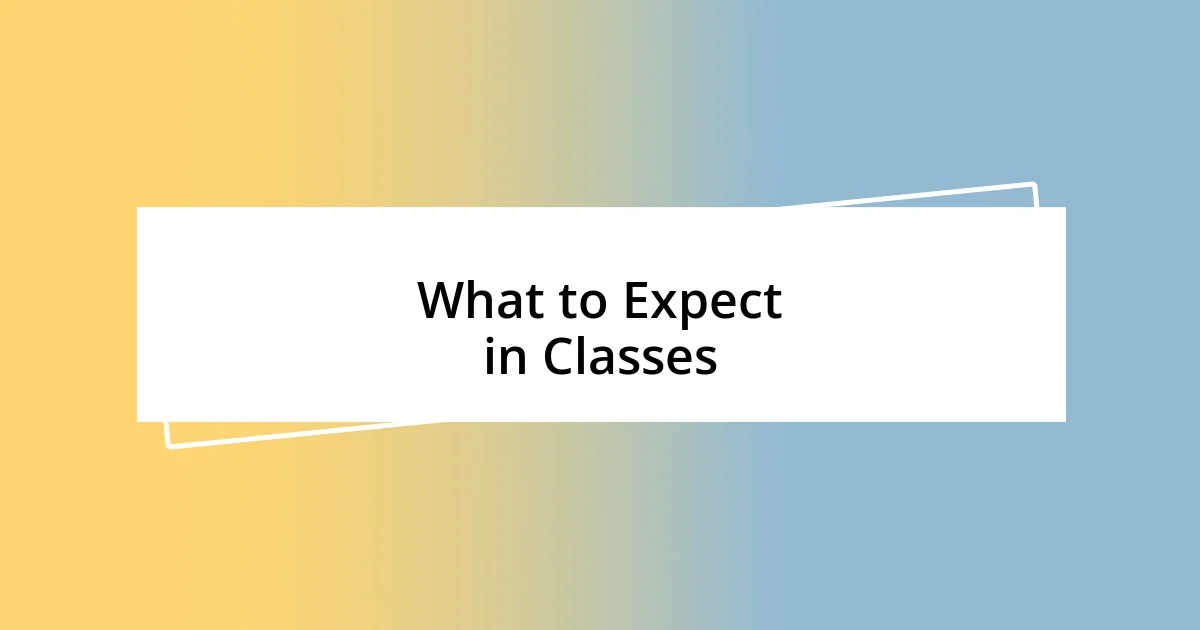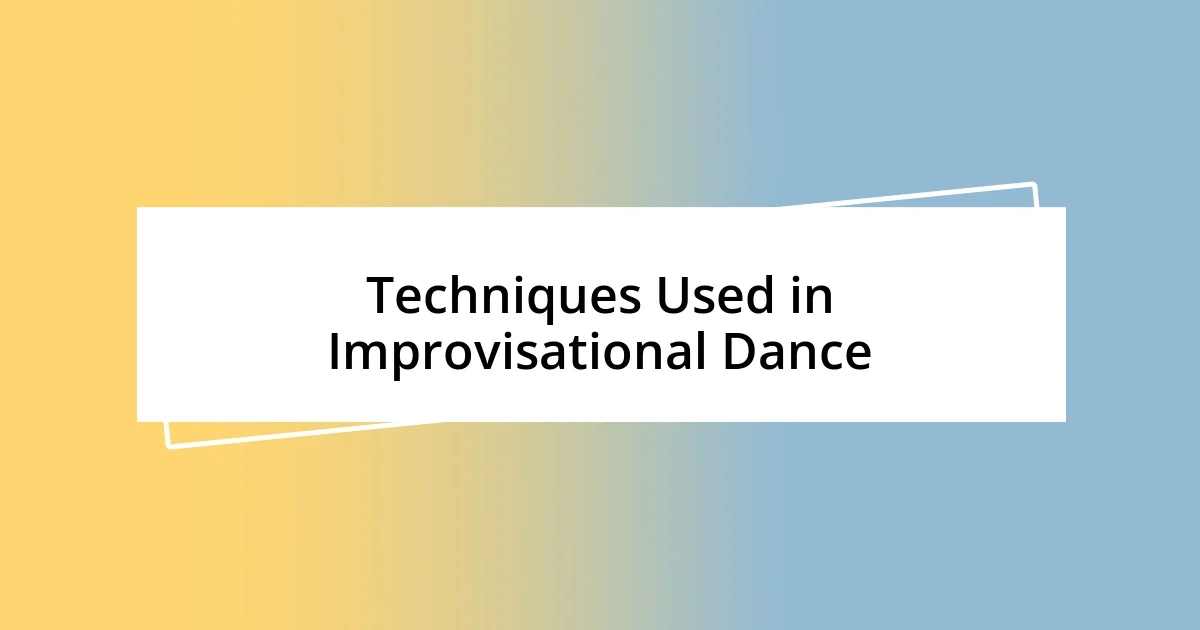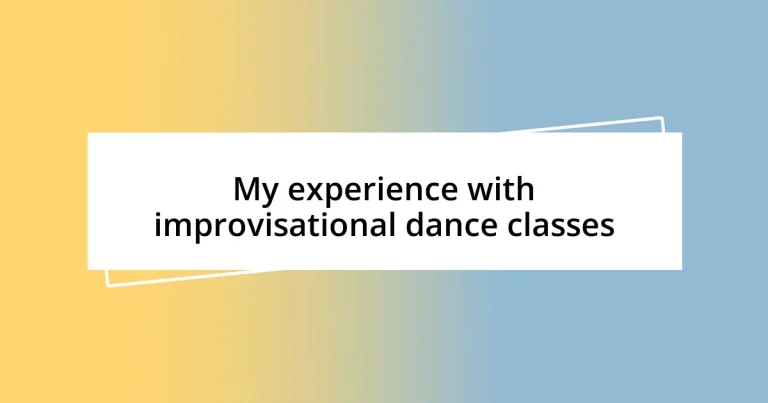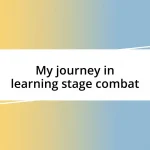Key takeaways:
- Improvisational dance fosters personal growth by enhancing confidence, encouraging cognitive agility, and providing a healthy emotional outlet.
- Techniques like movement prompts, mirroring, and breath connection are essential for unlocking creativity and facilitating deeper expression during classes.
- Overcoming performance anxiety through shared vulnerability, breath awareness, and visualization can transform the dance experience into one of joy and freedom.

Introduction to Improvisational Dance
Improvisational dance, at its core, is about freedom and expression. The first time I stepped into an improvisational dance class, I remember feeling a rush of excitement and anxiety. It was liberating to know there were no wrong moves—just a space filled with possibilities where my body could explore its own rhythm.
The beauty of improvisational dance lies in its spontaneity. Each session invites you to connect with your body and the environment in a raw, unfiltered way. I vividly recall one moment where a simple breath transformed into a wave of movement, and I felt as if I was not just dancing but communicating something deep within myself. Have you ever noticed how your emotions can shift in an instant when you move to your own beat? That’s the magic of improvisation; it taps into our innermost feelings and translates them into art.
In a society that often prioritizes structure and precision, improvisational dance offers a refreshing alternative. This art form encourages us to let go of perfectionism and embrace vulnerability. I’ve found that while dancing without a set routine can be intimidating, it also fosters a unique sense of community and connection with fellow dancers. By sharing this experience, I’ve discovered that we all bring our own stories to the floor, creating a tapestry of movement that is truly one-of-a-kind.

Benefits of Improvisational Dance Classes
Participating in improvisational dance classes has notable benefits for personal development. For instance, I’ve seen my confidence grow tremendously through this practice. The first time I ventured onto the dance floor, I felt exposed, but as I let go of my inhibitions, I became more comfortable expressing how I felt through movement. This transformation not only improved my dance skills but also seeped into other areas of my life, making me bolder in social situations and at work.
Another significant advantage is the cognitive boost that comes with improvisational dance. Engaging in unscripted movement requires a certain mental agility. I’ve often found myself making split-second decisions about how to move, and this sharpness translates into everyday problem-solving skills. It’s surprising how a few moments of improvisation can enhance your ability to think on your feet, whether you’re navigating a tricky conversation or tackling unexpected challenges.
Beyond personal growth, improvisational dance fosters emotional release. I remember one class where I entered feeling stressed and overwhelmed. By the end, my body had shed those worries, and I felt liberated, as if I had danced out my burdens. This release is something many participants share, creating a collective sense of relief and joy that I believe is truly transformative.
| Benefit | Description |
|---|---|
| Increased Confidence | Letting go of inhibitions leads to greater self-assuredness. |
| Cognitive Enhancement | Improvisational movement sharpens decision-making and problem-solving skills. |
| Emotional Release | Dancing allows for a healthy outlet for stress and emotions. |

What to Expect in Classes
When you step into an improvisational dance class, you can expect a warm, inviting atmosphere where everyone is eager to explore. I remember that first class vividly; the space was filled with laughter and nervous giggles, which immediately melted my anxiety away. The instructor encouraged us to surrender to the music and let our bodies lead, creating a sensation that was both unfamiliar and exhilarating. You may feel a mix of excitement and vulnerability as you move freely, but that’s all part of the journey.
Here’s what typically unfolds in a class:
- Warm-up Exercises: These help to connect you to your body and set the tone for the session.
- Guided Movement: Instructors often lead activities that encourage spontaneous expression, ranging from simple prompts to more complex challenges.
- Group Interactions: You’ll find yourself dancing alongside others, which fosters a beautiful sense of community and connection. Watching others express themselves often inspires your creativity.
- Reflection Periods: Classes often include moments to share experiences or feelings afterward, deepening the understanding of the emotional journey you just undertook.
At times, you might notice that the music speaks to you in ways you never anticipated. There was one instance when a haunting melody carried me to a place of nostalgia, and I found myself dancing in slow, sweeping motions that conveyed a story of longing. It was as if the music unearthed something buried within me, and those around me seemed to feel it too, mirroring my movements in a spontaneous dialogue of expression. That connection to the music and to each other is something I cherish in each class, making every moment feel like a shared adventure.

Techniques Used in Improvisational Dance
One of the standout techniques in improvisational dance is the practice of using movement prompts. I remember one class where the instructor asked us to explore the concept of “space.” At first, it felt broad and overwhelming, but as I allowed myself to focus on how my body interacted with the space around me, I discovered new ways to move. It was like peeling back layers of my creativity, revealing parts of my body that I hadn’t engaged before. Have you ever thought about how your movements can shift just by being mindful of your surroundings?
Another effective technique is the concept of “mirroring,” where dancers reflect each other’s movements in real-time. I’ve been in pairs during exercises where one person leads, and the other follows, almost like a dance conversation. This not only strengthens connection but opens up a whole new way to interpret what I see. Each subtle shift in my partner’s movement inspires my own, creating a blend of spontaneity and harmony that feels genuinely transcendent. It’s fascinating how just two bodies can create a tapestry of expression that shifts dynamically with each interaction.
Breath is also a core element in improvisational dance. In one particularly memorable session, the instructor encouraged us to sync our movements with our breath, leading to a beautiful, flowing rhythm. I found myself entranced by how the rise and fall of each inhalation and exhalation dictated the pace and energy of my movements. This connection to breath not only grounded me but also heightened my awareness of the emotions coursing through me as I danced. Have you ever noticed how your breath can influence your mood and movements? I found that simply tuning into my breath can unlock deeper expressions of joy and release.

How to Overcome Performance Anxiety
When faced with performance anxiety, I often remind myself that everyone in the room is navigating similar feelings. In one of my early classes, I felt my heart race and palms sweat as I stood at the edge of the dance floor. However, when I took a moment to look around and see others experiencing their own vulnerabilities, it created a comforting sense of solidarity. Have you ever noticed how vulnerability can become a shared experience that actually bonds us?
A practical technique that worked wonders for me was focusing on my breath before dancing. I recall a time when the instructor suggested we take deep, intentional breaths to center ourselves. As I inhaled deeply, I felt my body begin to relax and the anxiety started to dissipate. It was almost like I could feel the music reverberating through my chest, and I became more present in the moment. Have you ever used breath as an anchor during stressful situations? I highly recommend it; grounding yourself this way can transform how you approach performance.
Visualizing success has also been incredibly helpful for me. Before my solo debut at a class showcase, I spent time picturing myself dancing gracefully with confidence. In my mind, I danced as if I was in perfect sync with the music, and the anxiety melted away with each visualization. When my moment arrived, I found that my imagined success propelled me through the performance with a freedom I hadn’t believed possible. What if you embraced visualization as a tool? It could unlock new heights in your performance journey.

My Personal Challenges and Growth
In my journey through improvisational dance classes, I faced significant challenges that pushed me outside my comfort zone. There was a moment during a particularly intense session where I struggled to let go of my self-consciousness. I remember standing in the corner, feeling the urge to hide instead of express. What helped me was realizing that everyone else was just as uncertain. This shared struggle created a bond among us, turning my vulnerability into a source of strength.
As I began to navigate these personal hurdles, I found unexpected growth. I discovered that embracing spontaneity opened up new pathways for creativity. One class stands out vividly; I let the music take over and moved without thinking. It felt liberating, as if I was rediscovering parts of myself I had long suppressed. Can you think of a time when letting go of control led you to exciting new experiences? For me, it was like stepping into a dance that only I could choreograph, with each movement a celebration of my own evolution.
With each class, I also learned the importance of patience. Improvement didn’t come overnight; it unfolded slowly as I became more attuned to my body and surroundings. I used to get frustrated when I struggled with particular movements, but I learned to embrace those moments as opportunities for growth. After all, isn’t it the struggle that often teaches us the most? Each time I returned, I found more courage and joy within myself, turning those challenges into stepping stones on my path to becoming a more confident dancer.














